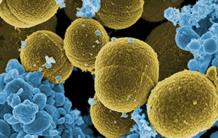Staphylococcus aureus, a leading cause of fatal bacterial infections worldwide, has been extensively studied. Research conducted by INRAE in collaboration with the BIAM has revealed a key protection mechanism of this bacterium against a toxic molecule found in mammalian blood. This breakthrough paves the way for developing new antibiotic strategies.
Bacterial infections are the second leading cause of death globally, with Staphylococcus aureus being among the deadliest. In France, it is one of the main culprits behind hospital-acquired infections and food poisoning. Despite antibiotics being the most effective treatment, resistant bacterial strains are constantly emerging, highlighting the need for a deeper understanding of the bacterial mechanisms involved in resistance. The INRAE and BIAM collaboration sheds light on the bacterium’s survival mechanism in blood.
Blood: a hostile environment for bacteria
In charge of fixing oxygen in red blood cells, heme in high concentrations is a toxic molecule for bacteria, including Staphylococcus aureus. So one could wonder how does Staphylococcus aureus manage to survive in the blood?

The bacterium uses a biosensor on its membrane called HssS to detect heme and initiate a defense response. “Staphylococcus synthesizes a heme efflux pump, forming a protective barrier that allows it to survive in blood and follow through with it’s infection mechanisms,” explain Marina Siponen and Pascal Arnoux, CNRS and CEA researchers at the BIAM. By employing Alphafold, an AI specializing in protein structure predictions, the researchers modeled the structure of the HssS sensor. Additionally, small molecule docking software was able to predict a heme binding site. Experimental heme binding studies of both the native protein and variants with specific amino acid changes validated this model. Further laboratory experiments confirmed that Staphylococcus aureus strains lacking the HssS sensor, and thus unable to detect heme in blood, exhibited significantly reduced virulence.
New Perspectives for Antibiotic Strategies
Faced with rising antibiotic resistances, these findings offer promising new directions for developing specific, new antibiotic strategies against Staphylococcus aureus. Targeting molecules that inhibit the HssS biosensor are particularly promising, as they could provide a pathogenic bacteria specific strategy, without affecting beneficial bacteria such as those constituting the intestinal microbiota.